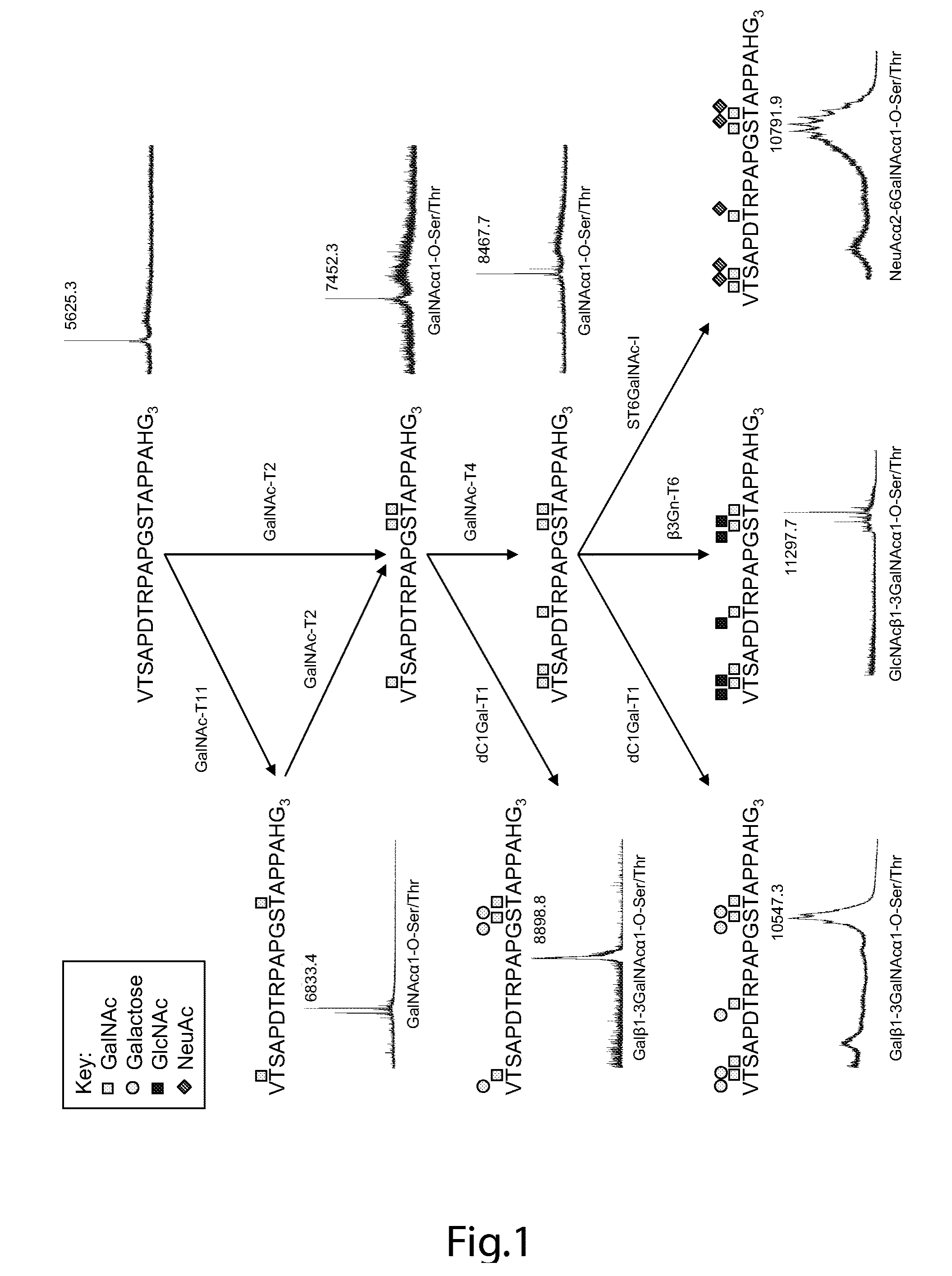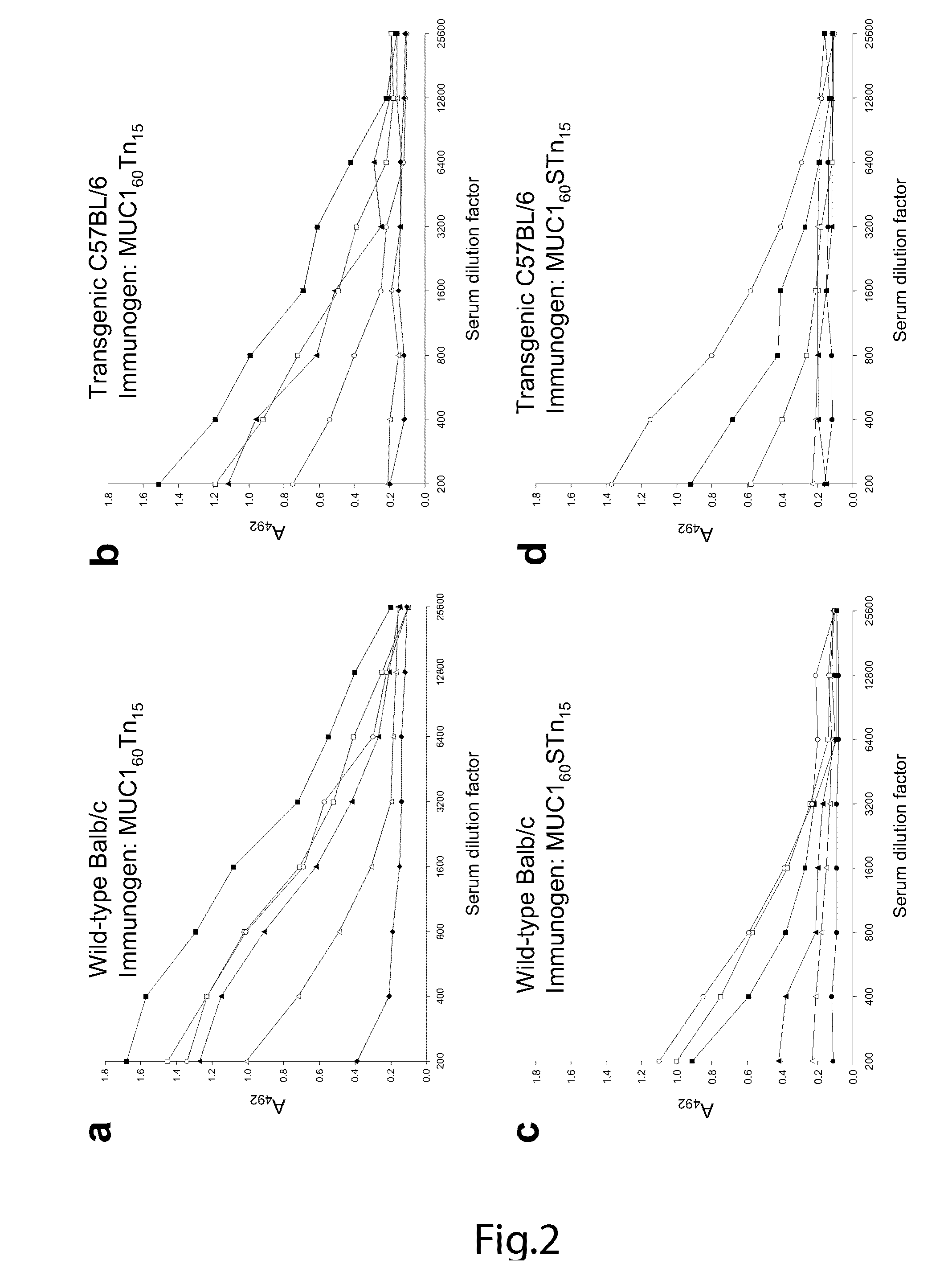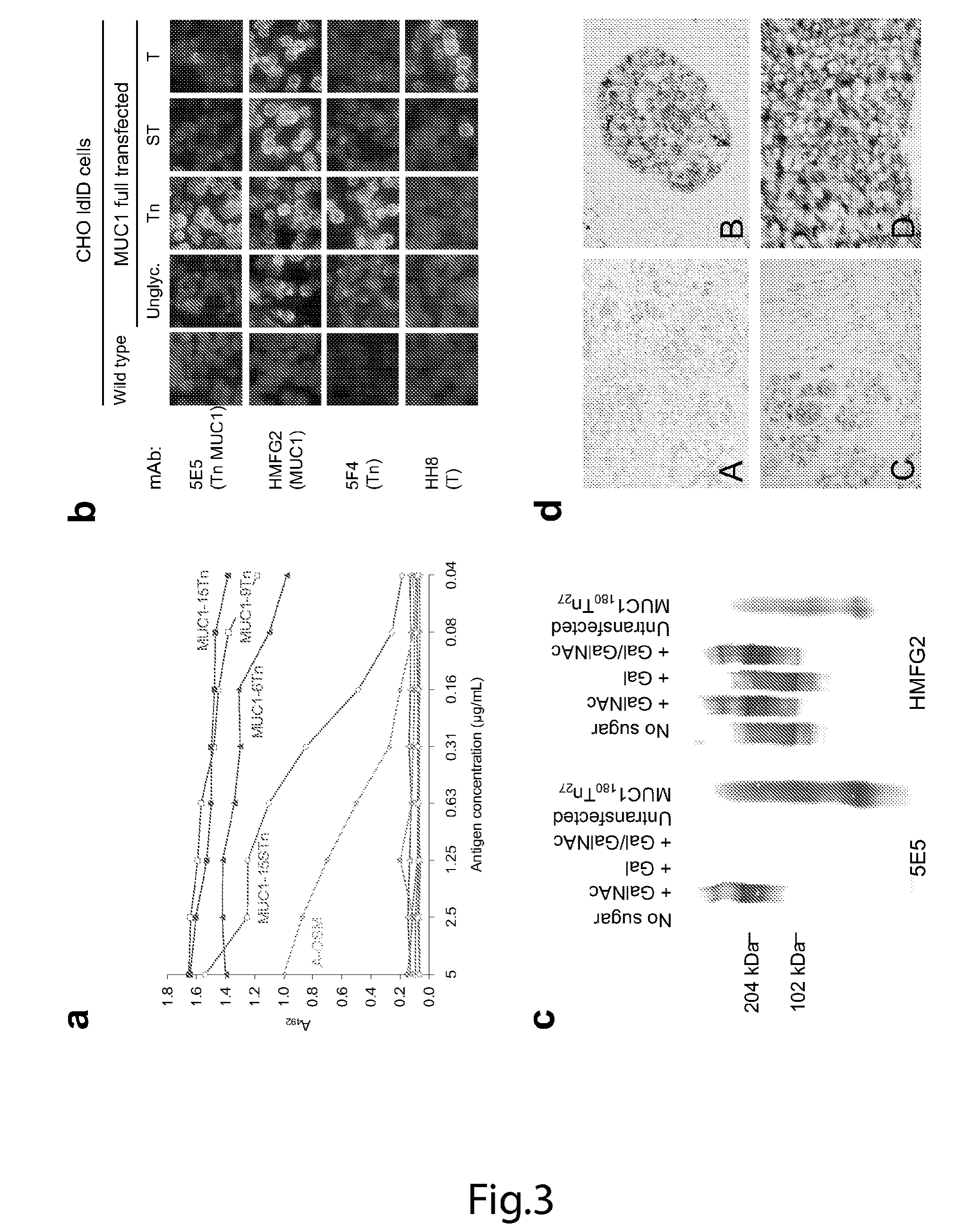Generation of a cancer-specific immune response toward MUC1 and cancer specific MUC1 antibodies
a cancer-associated form of muc1 and cancer-specific technology, applied in the field of cancer-specific immune response generation of muc1 and cancer-specific muc1 antibodies, can solve the problems of inability to stimulate an effective cellular or humoral immune response to cancer-associated forms of muc1 in patients or transgenic animals expressing human muc1 gene (using defined immunogens as opposed to cell based therapies), and the strategy of generating effective immune responses to muc1 expressed by cancer cells has generally
- Summary
- Abstract
- Description
- Claims
- Application Information
AI Technical Summary
Benefits of technology
Problems solved by technology
Method used
Image
Examples
example 1
Materials and Methods
[0147]Chemoenzymatic synthesis of multimeric Tn and STn MUC1 glycopeptides MUC1 60-mer (VTSAPDTRPAPGSTAPPAHG)n=3 (SEQ ID NO. 1) peptide was synthesized as originally reported by Fontenot. Control peptides used were derived from tandem repeat of MUC2 (PTTTPISTTTMVTPTPTPTC) (SEQ ID NO. 8) and MUC4 (CPLPVTDTSSASTGHATPLPV) (SEQ ID NO. 9). Peptides were glycosylated in vitro using purified recombinant human glycosyltransferases polypeptide GalNAc-T2, GalNAc-T4, and GalNAc-T11. The GalNAc substituted peptides were subsequently sialylated using purified recombinant mouse ST6GalNAc-I. GalNAc glycosylation of the peptides was performed in a reaction mixture (1 mg peptide / ml) containing 25 mM cacodylate buffer (pH 7.4), 10 mM MnCl2, 0.25% Triton X-100, and 2 mM UDP-GalNAc. Glycosylation of 1 mg 60-mer peptide with 2 GalNAc per TR (MUC160Tn6) was obtained using GalNAc-T11. Incorporation of 3 GalNAc per TR (MUC160Tn9) was obtained using GalNAc-T2. Substitution of all five p...
example 2
Materials and Methods
Chemoenzymatic Synthesis of Glycopeptides
[0160]A MUC1 60-mer peptide (VTSAPDTRPAPGSTAPPAHG)n=3 (SEQ ID NO. 1) representing three tandem repeats was synthesized (by Cancer Research UK) as originally reported. For immunization of mice, the peptide was completely Tn-glycosylated in vitro by concerted action of GalNAc-T2 and -T4 (see below). For capture ELISA, an NH2-terminal biotinylated variant of the 60-mer peptide was in vitro glycosylated to form 11 different glycoforms (FIG. 5). Furthermore, as control peptide a MUC2 33-mer peptide (PTTTPITTTTTVTPTPTPTGTQTPTTTPISTTC) (SEQ ID NO. 14) corresponding to 1.4 tandem repeat (kindly provided by Dr. P.O. Livingston) was Tn-glycosylated by GalNAc-T2 with an occupancy of approximately 12 out of 20 potential acceptor sites. Two valine-substituted NH2-terminal biotinylated 25-mer MUC1 peptides, TAP25V9 (T1APPAHGVV9SAPDTRPAPGST21APPA) (SEQ ID NO. 10) and TAP25V21 (T1APPAHGVT9SAPDTRPAPGSV21APPA), (SEQ ID NO. 11) were synthes...
example 3
Materials and Methods
[0177]A MUC1 60-mer peptide (VTSAPDTRPAPGSTAPPAHG)n=3 (SEQ ID NO. 1) representing three tandem repeats is glycosylated in vitro with 5 moles of Tn, STn, and T as described in Examples 1 and 2. Control glycopeptides includes the MUC2 33-mer peptide (PTTTPITTTTTVTPTPTPTGTQTPTTTPISTTC) (SEQ ID NO. 14) with the same glycoforms. Murine monoclonal anti-MUC1 antibodies, 5E10, 5E5 and 1B9, were described in Example 2. Murine monoclonal antibodies to Tn (3E1, 5F4), T (3F1, TKH2) and T (HH8, 3C9) are produced as previously described (Kjeldsen et al, 1989; Kjeldsen et al, 1988; Hirohashi et al, 1985; Clausen et al, 1988). Monosaccharides GalNAc, GlcNAc, Gal, Glc and NeuAc are bought from Sigma, GalNAcα-agarose (GlycoSorb-1) is bought from GlycoRex. OSM and asialo-OSM are prepared as previously described (Reis et al, 1998b; Reis et al, 1998a). BSM is bought from Sigma and asialo-BSM prepared as previously described by neuraminidase treatment (Reis et al, 1998b; Reis et al, ...
PUM
| Property | Measurement | Unit |
|---|---|---|
| pH | aaaaa | aaaaa |
| pH | aaaaa | aaaaa |
| total volume | aaaaa | aaaaa |
Abstract
Description
Claims
Application Information
 Login to View More
Login to View More - R&D
- Intellectual Property
- Life Sciences
- Materials
- Tech Scout
- Unparalleled Data Quality
- Higher Quality Content
- 60% Fewer Hallucinations
Browse by: Latest US Patents, China's latest patents, Technical Efficacy Thesaurus, Application Domain, Technology Topic, Popular Technical Reports.
© 2025 PatSnap. All rights reserved.Legal|Privacy policy|Modern Slavery Act Transparency Statement|Sitemap|About US| Contact US: help@patsnap.com



